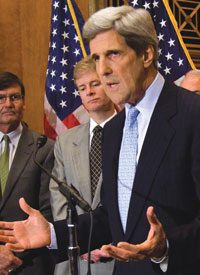
Last month, Senators John Kerry (D-Mass.) and Joe Lieberman (I-Conn.) unveiled their “American Power Act,” custom-tailored to President Obama’s plans to set up quotas for industrial greenhouse gas (GHG) emissions, with total allowable emissions reduced over time. Better known as cap and trade, the bill is an updated version of S. 1733, companion legislation to the House-passed Waxman-Markey bill, H.R. 2454. Kerry’s official home page brags that the new bill “puts America back in control of our own power generation, starts to clean up the carbon pollution that threatens our climate stability, and puts us on the path to a new, cleaner and more prosperous economy for the 21st Century.”
Kerry and Lieberman redrafted S. 1733 when Republican colleague Lindsey Graham of South Carolina withdrew his support of the legislation. In a May 7 press release, Graham admitted that “the House-passed cap and trade bill is dead,” thereby indicating that he was influenced by growing public sentiment against Capitol Hill’s climate-change agenda. An April Rasmussen poll found only 33 percent of Americans believe in man-made global warming, down from 47 percent just two years ago.
This growing public awareness is owing in part to last November’s “Climategate” scandal involving leaked e-mails that showed UN climate researchers mishandled and manipulated data to favor their own alarmist agenda. A number of gaffes followed in the wake of Climategate: dissension and infighting among delegates at December’s UN Climate Change Conference in Copenhagen; January’s revelations of deceit in various reports of the UN Intergovernmental Panel on Climate Change; Climategate scientist Phil Jones’ admission to the BBC in February that there has been no “statistically significant” warming for the last 15 years; and the Christian Science Monitor’s exposure of fraud in cap and trade.
Despite the negative publicity, congressional diehards remain steadfast in their crusade to pass climate-change legislation. But what of Kerry’s boast? Does cap and trade really mean cleaning up “carbon pollution” and ushering in a “more prosperous economy?”
A Hefty Tax
Experts disagree with Kerry’s cap-and-trade description. The U.S. Treasury Department released a 2009 analysis of the Waxman-Markey bill indicating that the cost to American taxpayers would be approximately $393 billion per year. According to Heritage Foundation senior analyst Ben Lieberman, cap and trade would cost $4 trillion by 2035, to fund the modest goal of reducing temperatures by only 0.2ºC.
These totals stand in sharp contrast to Obama’s claims in a June 2009 address to the House of Representatives that “the price to the average American will be about the same as a postage stamp.” Obama’s calculation was less than 1 percent of Treasury predictions, and far less than his own dauntingly ambiguous esti mate made in a January 2009 interview with the San Francisco Chronicle when he admitted, “Under my plan of a cap-and-trade system, electricity rates would necessarily skyrocket.”
Jim Johnston, senior fellow with the Heartland Institute, said that the new Kerry-Lieberman re-write offers nothing better. He summarized the bill at the Institute’s 4th International Climate Change Conference in May. The legislation mandates graduated limits on industrial GHG emissions, sets up a highly regulated GHG emissions trading system, and provides government subsidies for various energy and environmental initiatives such as natural gas and electric vehicles as well as wind and solar power.
Its schedule of emissions restrictions starts with a 17-percent cut in 2005 levels by 2020 and builds to 83 percent by 2050. This will reduce the amount of energy coming into the economy, driving prices up by two-and-a-half times the percentage reduction in emissions. “There is going to be serious damage to the economy,” said Johnston, “and I don’t see very much relief coming until it becomes evident that emissions reductions do not mitigate warming.”
Green Jobs
Cap and trade also promises to significantly damage U.S. employment. It would likely offshore more American jobs, since countries like China and India do not levy GHG taxes. In a February 2009 interview with the New York Times, Energy Secretary Steven Chu said, “The concern about cap-and-trade in today’s economic climate is that a lot of money might flow to developing countries in a way that might not be completely politically sellable.”
Enthusiasts argue that “green jobs” would offset any adverse effect. But the Congressional Budget Office published an analysis in May that concluded green jobs would not even compensate for the loss in domestic jobs inflicted by cap and trade. The report read, “In particular, job losses in the industries that shrink would lower employment more than job gains in other industries would increase employment, thereby raising the overall unemployment rate.”
Ironically, President Obama points to Spain as a role model for renewable energy policies in cap and trade, promising “millions of additional jobs and entire new industries.” However, Dr. Gabriel Calzada Alvarez, professor of economics at King Juan Carlos University, sums up the cost of a decade of green energy subsidies in Spain: 2.2 jobs were lost for each of the 50,200 green jobs created, and 28.6 billion euros were spent. He told Heartland Institute conference attendees that public aid to renewables cost more in 2009 than electricity production for the entire country, noting that the unit cost of renewable energies is 3.3 times that of other energy sources. This misallocation of resources is certainly a contributing factor to Spain’s skyrocketing unemployment and public debt. The Institute for Energy Research, in its critique of Alvarez’s 2009 Study of the Effects on Employment of Public Aid to Renewable Energy Sources, said that “the United States should expect a worse return (measured in job creation) from its own subsidies to renewables.”
Command and Control
Considering the economic consequences of legislation crafted to combat what more and more voters view as a non-problem, cap and trade probably does not have enough support to pass the Senate this year. President Obama admitted as much during a February town hall meeting, yet he urged congressional action to prevent having to “involve some big bureaucracy in a control-and-command system.” His remark echoed that made by a White House official to Fox News in December: “The EPA [Environmental Protection Agency] is going to have to regulate in this area. And it is not going to be able to regulate in a market-based way, so it’s going to have to regulate in a command-and-control way.”
EPA is not wasting any time. In February, agency Administrator Lisa Jackson announced plans to begin regulating large industrial facilities’ GHG emissions in 2011 and those of smaller plants by 2016. Automobile manufacturers have already received new GHG emission standards for 2012 models. Jackson said that the regulations “are consistent with the call for comprehensive energy and climate legislation,” ignoring the fact that cap and trade has not passed Congress.
These sweeping regulatory powers stem from an April 2007 Supreme Court reinterpretation of the Clean Air Act authorizing EPA to regulate GHG emissions. The agency issued an “endangerment finding” last December, naming six GHGs, including CO2, as dangerous to public health and welfare. EPA senior analyst Alan Carlin wrote a harshly critical review of the ruling at the time, but the agency suppressed his report and reassigned him. He has since retired, and the Competitive Enterprise Institute published his paper, entitled “Comments on Draft Technical Support Document for Endangerment Analysis for greenhouse Gas Emissions Under the Clean Air Act.” It shows that EPA based the finding on unsubstantiated data and unrealistic assumptions. Carlin says the agency plays a “pivotal role in the global green climate control conspiracy.”
Mitigating EPA
Legislators are scrambling to shackle EPA’s Stalinist tactics. “The rules proposed by EPA are a virtual gun to the head of Congress,” U.S. Representative Marsha Blackburn (R-Tenn.) said in a press release. “The EPA is rushing to implement [cap-and-trade legislation] before it is passed.”
Blackburn introduced legislation to prevent CO2 and other GHGs from being classified as air pollutants in the Clean Air Act. A bill sponsored by her colleague Earl Pomeroy (D-N.D.) would prohibit EPA from regulating GHGs altogether. And H.R. 4753 by Congressman Nick Rahall (D-W.Va.) would suspend EPA authority over stationary sources for the next two years. All three pieces of legislation have been sitting stagnant in the House Committee on Energy and Commerce for months.
Impatient with similar inactivity on her resolution to disapprove and nullify EPA’s endangerment finding, Senator Lisa Murkowski (R-Alaska) reached an agreement with Democratic leadership for a vote in June. It would undoubtedly face presidential veto if passed by Congress, but even if successfully enacted into law the resolution would only prevent regulations for stationary sources for one year while doing nothing to stop EPA from regulating automobiles.
Eco-government
The most glaring weakness in each piece of legislation mentioned above is a blatant disregard for constitutional constraints. The author of each bill argues that only Congress has authority to enact climate-change policy. On the contrary, the U.S. Constitution includes no enumerated powers related to climate or energy. Former U.S. Senator and NASA astronaut Harrison Schmitt says that both EPA regulations and cap-and-trade legislation violate the Constitution. At the Heartland Institute conference, Schmitt explained that federal authority is limited to issues of national defense. “Cap and trade actually jeopardizes national security,” he argued. “It reduces the energy supply, weakening the country’s ability to defend itself.”
What explains this suicidal cap-and-trade agenda? “Alarmists look on abundant energy as a peril to be controlled,” said Christopher Horner of the Competitive Enterprise Institute. “It was never about climate. The environmental agenda seeks to use the state to create scarcity as a means to exert the state’s authority over your lives,” he told Heartland conference attendees in May.
But the matter extends beyond the federal level, as domestic cap and trade would merely prime the nation for UN global eco-government. According to Lord Christopher Monckton, former Policy Advisor to British Prime Minister Margaret Thatcher, the climate treaty prepared for Copenhagen proposes an international government composed of an executive board and more than 300 new bureaucracies “to which the market rules and related dynamics should be subordinate.” It also calls for a tax on wealthy nations of two percent of GDP, and another two-percent tax on all financial transactions.
This treaty will be the subject of debate at the next UN Climate Change Conference in Mexico this fall, and the White House has already promised its support whether or not Congress approves. Monckton warned that Western democracy and its “one leveling constitutional practice,” the ballot box, are at stake. It will be up to American voters to elect a Congress this November with the courage to protect and defend America from all enemies of her Constitution, both foreign and domestic.
Ask the Experts
Climate-change alarmists are quite candid about the underlying motive of cap and trade, and science has nothing to do with it. Consider the following:
“Every aspect of our lives must be subjected to an inventory.”
— House Speaker Nancy Pelosi, plugging personal carbon ration cards during a trip to China in 2009
“You have to find ways to exaggerate the threat…. I sometimes wish that we could have, over the next five or ten years, a lot of horrid things happening — you know, like tornadoes in the Midwest and so forth — that would get people very concerned about climate change.”
— Thomas Schelling, Nobel Prize-?winning economist and former ?presidential advisor
“We want to move from suicidal gray capitalism … so the green economy will start off as a small subset, and we’re going to push it, and push it, and push it, until it becomes the engine for transforming the whole society.”
— Obama’s future (and now former) Green Jobs Czar Van Jones ?in a 2008 interview
“We need to make sure that … eventually, we can get to a system where an electric company will be able to hold back some of the power so that maybe your air conditioner won’t operate at its peak.”
— Energy and Climate Czar Carol Browner in a March 2009 interview with U.S. News & World Report
“Stop building airports, switch to electric cars and shut down coal-fired power stations as part of a ‘planned recession’ to avoid dangerous climate change.”
— A September 2009 London Telegraph column offering advice for Britain
“We must leave behind 10,000 years of civilization…. If we live at all, we will have to figure out how to live locally … [which] means we are able to get everything we need in walking (or animal riding) distance.”
— Columnist Adam D. Sacks writing in Grist magazine, August 2009
“One of the ways [global-warming awareness] will drive the change is through global governance and global agreements.”
— Former Vice President Al Gore, extolling the virtues of the Waxman-Markey bill after it passed the House in 2009
“This is not an environment bill.”
— Senator John Kerry (D-Mass.) ?on cap and trade
“It’s not a global warming bill to me, because global warming as a reason to pass legislation doesn’t exist anymore.”
— Senator Lindsey Graham (R-S.C.) ?on cap and trade
“Cap-and-trade is a tax, and it’s a great big one.”
— Representative John Dingell ?(D-Mich.)




